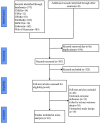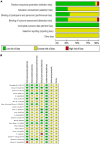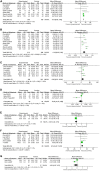Does whole-body vibration training have a positive effect on balance and walking function in patients with stroke? A meta-analysis
- PMID: 36684839
- PMCID: PMC9846107
- DOI: 10.3389/fnhum.2022.1076665
Does whole-body vibration training have a positive effect on balance and walking function in patients with stroke? A meta-analysis
Abstract
Objective: After a stroke, patients usually suffer from dysfunction, such as decreased balance ability, and abnormal walking function. Whole-body vibration training can promote muscle contraction, stimulate the proprioceptive system, enhance the muscle strength of low limbs and improve motor control ability. The study aims to evaluate the effectiveness of whole-body vibration training on the balance and walking function of patients with stroke.
Methods: PubMed, CNKI, VIP, CBM, EBSCO, Embase and Web of Science were searched. According to the inclusion and exclusion criteria, randomized controlled trials on the effectiveness of whole-body vibration training on the balance and walking function of patients with stroke were collected. The search time ranged from the date of database construction to November 2022. The included trials were evaluated by the Cochrane risk-of-bias tool. The meta-analysis was performed using two software packages, consisting of RevMan 5.4 and Stata 12.2. If the results included in the literature were continuous variables, use the mean difference (MD) and 95% confidence interval (CI) for statistics.
Results: (1) A total of 22 randomized controlled trials (RCTs) with a total of 1089 patients were included. (2) The results of meta-analysis showed that: compared with the controls, step length (MD = 6.12, 95%CI [5.63, 6.62], p < 0.001), step speed (MD = 0.14, 95%CI [0.09, 0.20], p < 0.001), cadence (MD = 9.03, 95%CI [2.23, 15.83], p = 0.009), stride length (MD = 6.74, 95%CI [-3.47, 10.01], p < 0.001), Berg Balance Scale (BBS) (MD = 4.08, 95%CI [2.39, 5.76], p < 0.001), Timed Up-and-Go test (TUGT) (MD = -2.88, 95%CI [-4.94, 0.81], p = 0.006), 10-meter Walk Test (10MWT) (MD = -2.69, 95%CI [-3.35, -2.03], p < 0.001), functional ambulation category scale (FAC) (MD = 0.78, 95%CI [0.65, 0.91], p < 0.001), Fugl-Meyer motor assessment of lower extremity (FMA-LE) (MD = 4.10, 95%CI [2.01, 6.20], p = 0.0001). (3) The results of subgroup analysis showed that, compared with other vibration frequencies, at 20-30 Hz frequency, WBV training had an obvious improvement effect only in TUGT. (4) The safety analysis showed that WBV training may be safe.
Conclusion: Whole-body vibration training has a positive effect on the balance and walking function of patients with stroke. Thus, whole-body vibration training is a safe treatment method to improve the motor dysfunction of patients with stroke.
Systematic review registration: [http://www.crd.york.ac.uk/PROSPERO], identifier [CRD4202348263].
Keywords: balance; meta-analysis; stroke; walking function; whole-body vibration training.
Copyright © 2023 Yin, Wang, Yu, Zhou, Liu, Cai and Sun.
Conflict of interest statement
The authors declare that the research was conducted in the absence of any commercial or financial relationships that could be construed as a potential conflict of interest.
Figures








Similar articles
-
Effect of constraint-induced movement therapy on lower extremity motor dysfunction in post-stroke patients: A systematic review and meta-analysis.Front Neurol. 2022 Nov 21;13:1028206. doi: 10.3389/fneur.2022.1028206. eCollection 2022. Front Neurol. 2022. PMID: 36479056 Free PMC article.
-
Effects of body weight support training on balance and walking function in stroke patients: a systematic review and meta-analysis.Front Neurol. 2024 Aug 27;15:1413577. doi: 10.3389/fneur.2024.1413577. eCollection 2024. Front Neurol. 2024. PMID: 39258157 Free PMC article.
-
Effects of Aquatic Exercise and Land-Based Exercise on Cardiorespiratory Fitness, Motor Function, Balance, and Functional Independence in Stroke Patients-A Meta-Analysis of Randomized Controlled Trials.Brain Sci. 2021 Aug 20;11(8):1097. doi: 10.3390/brainsci11081097. Brain Sci. 2021. PMID: 34439716 Free PMC article. Review.
-
Effect of robotic exoskeleton training on lower limb function, activity and participation in stroke patients: a systematic review and meta-analysis of randomized controlled trials.Front Neurol. 2024 Aug 13;15:1453781. doi: 10.3389/fneur.2024.1453781. eCollection 2024. Front Neurol. 2024. PMID: 39193147 Free PMC article.
-
The Effects of Transcranial Direct Current Stimulation on Balance and Gait in Stroke Patients: A Systematic Review and Meta-Analysis.Front Neurol. 2021 May 25;12:650925. doi: 10.3389/fneur.2021.650925. eCollection 2021. Front Neurol. 2021. PMID: 34113308 Free PMC article.
Cited by
-
What specific exercise training is most effective exercise training method for patients on maintenance hemodialysis with sarcopenia: a network meta-analysis.Front Nutr. 2024 Nov 22;11:1484662. doi: 10.3389/fnut.2024.1484662. eCollection 2024. Front Nutr. 2024. PMID: 39650714 Free PMC article.
-
Changes in cortical activation during proprioceptive stimulation and galvanic vestibular stimulation in healthy individuals and individuals with post-stroke balance disorders: A functional near-infrared spectroscopy study.Neuroimage Clin. 2025 Jun 8;47:103822. doi: 10.1016/j.nicl.2025.103822. Online ahead of print. Neuroimage Clin. 2025. PMID: 40499477 Free PMC article.
-
Upper extremity function and disability recovery with vibration therapy after stroke: a systematic review and meta-analysis of RCTs.J Neuroeng Rehabil. 2024 Dec 21;21(1):221. doi: 10.1186/s12984-024-01515-6. J Neuroeng Rehabil. 2024. PMID: 39707380 Free PMC article.
-
Network meta-analysis of the intervention effects of different exercise measures on Sarcopenia in cancer patients.BMC Public Health. 2024 May 10;24(1):1281. doi: 10.1186/s12889-024-18493-y. BMC Public Health. 2024. PMID: 38730397 Free PMC article.
-
Impact of whole-body vibration training on ankle joint proprioception and balance in stroke patients: a prospective cohort study.BMC Musculoskelet Disord. 2024 Oct 1;25(1):768. doi: 10.1186/s12891-024-07906-z. BMC Musculoskelet Disord. 2024. PMID: 39354501 Free PMC article. Clinical Trial.
References
Publication types
LinkOut - more resources
Full Text Sources

